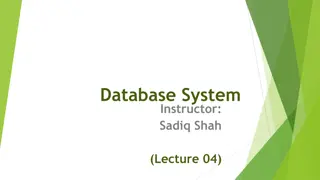Understanding Entities and Relationships in Database Design
Explore the concepts of entities, entity sets, attributes, key attributes, single-valued and multi-valued attributes, derived attributes, as well as relationships and relationship sets in the context of database design. Gain insights into distinguishing between regular entities, weak entities, and entity instances. Uncover the significance of keys in defining entities and their attributes. Delve into the importance of relationships between entities and how they are represented using attributes.
Download Presentation

Please find below an Image/Link to download the presentation.
The content on the website is provided AS IS for your information and personal use only. It may not be sold, licensed, or shared on other websites without obtaining consent from the author. Download presentation by click this link. If you encounter any issues during the download, it is possible that the publisher has removed the file from their server.
E N D
Presentation Transcript
Entities and Entity Sets Entity: A real-world object distinguishable from other objects in an enterprise (e.g., University, Students and Faculty) Described using a set of attributes Entity set: A collection of similar entities (e.g., all employees) All entities in an entity set have the same set of attributes (until we consider ISA hierarchies, anyway!) Each entity set has a key Each attribute has a domain
Entity Entity : Any thing that has an independent existence and about which we collect data. Entity instance : Entity instance is a particular member of the entity type. Example for entity instance : A particular employee Regular Entity: An entity which has its own key attribute is a regular entity. Example for regular entity : Employee. Weak entity : An entity which depends on other entity for its existence and doesn't have any key attribute of its own is a weak entity. Example for a weak entity : In a parent/child relationship, a parent is considered as a strong entity and the child is a weak entity
Attributes Attributes: Properties/characteristics which describe entities are called attributes. Domain of Attributes: The set of possible values that an attribute can take is called the domain of the attribute. For example, the attribute day may take any value from the set {Monday, Tuesday ... Friday}. Key attribute :The attribute (or combination of attributes) which is unique for every entity instance is called key attribute. E.g the employee_id If the key attribute consists of two or more attributes in combination, it is called a composite key.
Attributes Single valued Attributes & Multi-valued Attributes The attributes that can have only one value for a given entity are called the single-valued attributes. For example, the attribute Book_title is a single-valued attribute as one book can have only one title. The attributes that can have multiple values for a given entity are called multi-valued attributes. For example, the attributes Email_ID and Phone of the entity type PUBLISHER are multi-valued attributes, as a publisher can have zero, one or more e-mail IDs and phone numbers. Derived Attribute: An attribute which can be calculated or derived based on other attributes is a derived attribute
Tools and An ER Diagram Entities ( Entity Sets ) Attributes name ssn lot ssn is the primary key, hence, underlined Employees
Relationship and Relationship Sets Relationship: Association among two or more entities (e.g., Mohammad is teaching 0721351) Described using a set of attributes Relationship set: Collection of similar relationships Same entity set could participate in different relationship sets, or in different roles in the same set
Relationships Relationships Associations between entities are called relationships Example : An employee works for an organization. Here "works for" is a relation between the entities employee and organization.
Degree of a Relationship Degree of a relationship is the number of entity types involved. The n-ary relationship is the general form for degree n. Such as: unary, binary, and ternary ,where the degree is 1, 2, and 3, respectively. Example for unary relationship : An employee is a manager of another employee Example for binary relationship : An employee works-for department. Example for ternary relationship : customer purchase item from a shop keeper
More Tools and ER Diagrams N M Relationships ( rel. sets ) and mapping constraints P since name dname ssn budget lot did Works_In Employees Departments A Binary Relationship
Relationship Set Married wife husband Husband Wife Bob Joe name Ann Sue Teachers ssn lot Employees super- visor subor- dinate Reports_To A Self-Relationship
Ternary Relationships Suppose that departments have offices at different locations and we want to record the locations at which each employee works Consequently, we must record an association between an employee, a department and a location since name dname ssn budget lot did Works_In Employees Departments address Locations capacity This is referred to as a Ternary Relationship (vs. Self & Binary Relationships)
Cardinalities Entities can be related to one another as one-to-one , one-to- many and many-to-many This is said to be the cardinality of a given entity in relation to another 1 1 1 N One-to-One Many-to-One One-to-Many Many-to-Many N M
Cardinalities: Examples 1 1 has CAPITAL COUNTRY 1 N owns CAR PERSON N M takes SECTION STUDENT
Cardinalities: Examples 1 1 has CAPITAL COUNTRY 1 to N notation 1 N owns CAR PERSON N M takes SECTION STUDENT
A Working Example Requirements: Students take courses offered by instructors; a course may have multiple sections; one instructor per section How to start? Nouns -> entity sets Verbs -> relationship sets
... name STUDENT ssn INSTRUCTOR issn Primary key = unique identifier underline
... name STUDENT c-id ssn c-name COURSE INSTRUCTOR issn But: sections of a course (with different instructors)?
ssn STUDENT c-id COURSE SECTION s-id But: s-id is not unique... (see later) INSTRUCTOR issn
ssn STUDENT c-id COURSE SECTION s-id Q: how to record that students take courses? INSTRUCTOR issn
ssn STUDENT N c-id takes M COURSE s-id SECTION INSTRUCTOR issn
STUDENT N c-id takes M s-id SECTION COURSE N teaches 1 INSTRUCTOR
STUDENT N c-id takes M 1 N has s-id SECTION COURSE N teaches 1 INSTRUCTOR
ssn STUDENT N takes s-id M c-id N 1 SECTION has COURSE N teaches 1 INSTRUCTOR
Participation Constraints Next lecture























